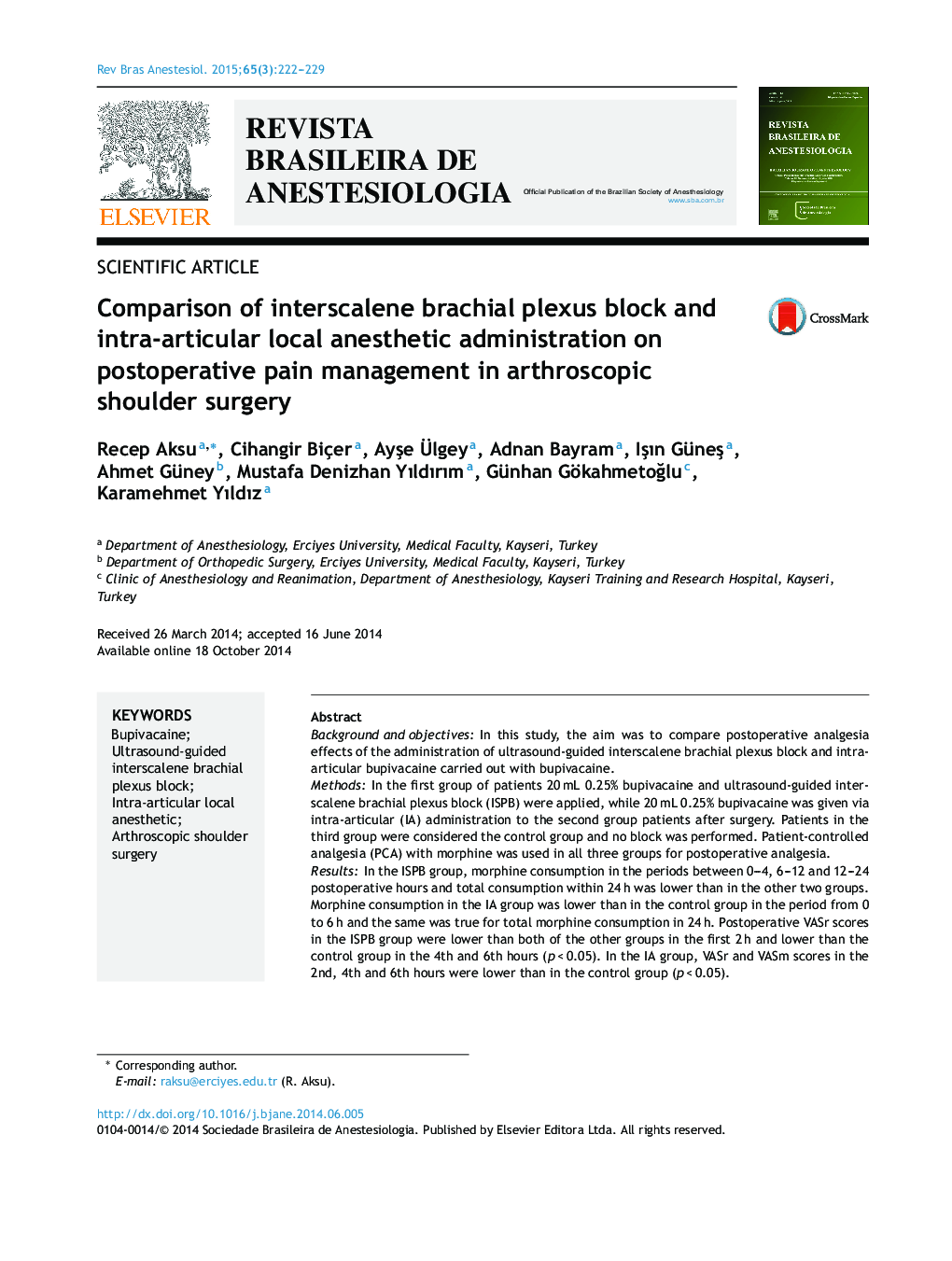| کد مقاله | کد نشریه | سال انتشار | مقاله انگلیسی | نسخه تمام متن |
|---|---|---|---|---|
| 2750358 | 1567304 | 2015 | 8 صفحه PDF | دانلود رایگان |
Background and objectivesIn this study, the aim was to compare postoperative analgesia effects of the administration of ultrasound-guided interscalene brachial plexus block and intra-articular bupivacaine carried out with bupivacaine.MethodsIn the first group of patients 20 mL 0.25% bupivacaine and ultrasound-guided interscalene brachial plexus block (ISPB) were applied, while 20 mL 0.25% bupivacaine was given via intra-articular (IA) administration to the second group patients after surgery. Patients in the third group were considered the control group and no block was performed. Patient-controlled analgesia (PCA) with morphine was used in all three groups for postoperative analgesia.ResultsIn the ISPB group, morphine consumption in the periods between 0–4, 6–12 and 12–24 postoperative hours and total consumption within 24 h was lower than in the other two groups. Morphine consumption in the IA group was lower than in the control group in the period from 0 to 6 h and the same was true for total morphine consumption in 24 h. Postoperative VASr scores in the ISPB group were lower than both of the other groups in the first 2 h and lower than the control group in the 4th and 6th hours (p < 0.05). In the IA group, VASr and VASm scores in the 2nd, 4th and 6th hours were lower than in the control group (p < 0.05).ConclusionInterscalene brachial plexus block was found to be more effective than intra-articular local anesthetic injection for postoperative analgesia.
ResumoJustificativa e objetivosNeste estudo, o objetivo foi comparar os efeitos da analgesia no pós-operatório da administração de bloqueio do plexo braquial por via interescalênica guiado por ultrassom e bupivacaína intra-articular, realizado com bupivacaína.MétodosNo primeiro grupo de pacientes, 20 mL de bupivacaína a 0,25% e bloqueio do plexo braquial por via interescalênica guiado por ultrassom (BPBI) foram administrados, enquanto 20 mL de bupivacaína a 0,25% foram administrados por via intra-articular (IA) ao segundo grupo de pacientes após a cirurgia. Os pacientes do terceiro grupo foram considerados grupo controle e nenhum bloqueio foi realizado. Analgesia controlada pelo paciente (ACP) com morfina foi usada nos três grupos para analgesia pós-operatória.ResultadosNo grupo BPBI, o consumo de morfina nos períodos entre 0-4; 6-12 e 12-24 horas após a cirurgia e o consumo total em 24 horas foram mais baixos que nos outros dois grupos. O consumo de morfina no grupo IA foi menor que no grupo controle no período de 0-6 horas, como também foi menor o consumo total de morfina em 24 horas. Os escores EVAr no pós-operatória do grupo BPBI foram menores que os escores dos dois outros grupos nas primeiras 2 horas e menores que os do grupo controle nos peródos de 4 e 6 horas (p < 0,05). No grupo IA, os escores EVAr e EVAM nos períodos de 2, 4 e 6 horas foram menores que no grupo controle (p < 0,05).ConclusãoO bloqueio do plexo braquial por via interescalênica mostrou ser mais eficaz que a injeção intra-articular de anestésico local para analgesia pós-operatória.
Journal: Brazilian Journal of Anesthesiology (English Edition) - Volume 65, Issue 3, May–June 2015, Pages 222–229
